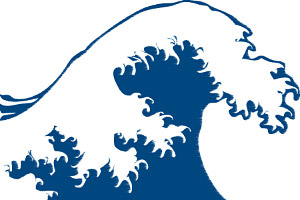Unlike the land's four seasons, in our ocean the "seasons of the sea" are three:
Winter Storm: December - February
Storms from the north and west build enormous swells and bring winter squalls. Tendrils of freshwater flow out the Golden Gate, swirling into the gulf, changing its chemistry.
Coastal waters are at their coldest. Gray whales pass near shore en route from Arctic feeding grounds to Mexican breeding grounds, while elephant seals, fattened by months foraging at sea, gather on beaches to enact primal mating and pupping rituals. Seabirds 'prospect' for nesting sites on the Farallones and coastal cliffs. Between storms the air shimmers brilliantly above the frigid ocean surface.
Open Ocean |
Whale Watching: California gray whale migration peaks mid-January. Watch for wintering waterfowl. |
|---|---|
Farallon Islands |
Visible from coastal headlands, Pt. Reyes Lighthouse overlook. |
Rocky Shore |
Tidepooling: Fitzgerald Marine Reserve, Duxbury Reef, Pigeon Point. Species similar year-round: sea urchins, sculpins, crabs, anemones, the elusive octopus! Best at lowest tides: check tide tables and high surf alerts. Avoid pocket beaches at incoming tides. "Don't turn your back to the sea!" |
Sandy Beach |
Enjoy a winter beach walk, look for washed-up sea glass, jellies, other flotsam. Stinson Beach, Great Beach, Linda Mar, Bolinas Beach are just a few. |
Bay/Marsh/Estuary |
Paddle calm waters and encounter shy harbor seals, leopard sharks, and bat rays. Stop at roadside pullouts to spot seals! |
Virtual Visits |
Greater Farallones National Marine Sanctuary Visitor Center, Presidio (SF) California Academy of Sciences (SF): California Coast Exhibit Point Reyes National Seashore: Bear Valley Visitor Center (Olema) |
Upwelling: March - August
Brisk spring winds churn up cold, nutrient-rich waters from the deep ocean, and sunlight sparks photosynthesis in microscopic sea plants. Tiny animals feed on them, and in turn become food for fish, seabirds, sharks and whales. Seabirds breed in raucous colonies on islands and cliffs, and giant whales move in to feast on fish and krill. The Pacific High pressure system holds storms at bay, sometimes shrouding the coast in fog.
This is prime seabird nesting season (look for Tufted Puffins!) at the Farallon Islands, and dinnertime for hungry humpbacks and blue whales in surrounding sanctuary waters.
Open Ocean |
Whale Watching: Northbound grays (through June), prime time for humpbacks, blue whales and seabirds. |
|---|---|
Farallon Islands |
Whales (blues, humpbacks), nesting seabirds, other marine life viewing on day cruises around islands. (May-Nov.). |
Rocky Shore |
Tidepooling: Fitzgerald Marine Reserve, Duxbury Reef, Pigeon Point. Species similar year-round: sea urchins, sculpins, crabs, anemones, the elusive octopus! Best at lowest tides: check tide tables and high surf alerts. Avoid pocket beaches at incoming tides. "Don't turn your back to the sea!" |
Sandy Beach |
Surf, paddleboard, spend a day or a quiet evening at the beach. Watch squadrons of pelicans skim the wave tops, or build a sand mermaid. |
Bay/Marsh/Estuary |
At Bolinas Lagoon watch egret mating displays, hear piping marsh birds. Harbor seal pups appear with their moms on the mudflats. |
Virtual Visits |
Greater Farallones National Marine Sanctuary Visitor Center, Presidio (SF) California Academy of Sciences (SF): California Coast Exhibit Point Reyes National Seashore: Bear Valley Visitor Center (Olema) |
Oceanic: September - November
As the winds slow or reverse direction in the fall, the ocean 'relaxes,' upwelling ceases, and warm surface waters shift back toward the coast. Larval fish and invertebrates are swept inshore to settle and grow. Seabird rookeries fall quiet as the last chicks fledge. The water becomes clearer, inviting white sharks to delectable seal meals.
Giant leatherback sea turtles and mola mola sunfish dine on jellies and squid, while flocks of shearwaters feed and fatten before returning to New Zealand nesting sites. This is a welcome stopover for other migrating birds along the Great Pacific Flyway.
Open Ocean |
Whale Watching: Great time for humpback and blue whales, mola molas, sea turtles, sharks. |
|---|---|
Farallon Islands |
Whales (blues, humpbacks); see dolphins, porpoise, blue sharks, white sharks; from day-cruise boats. |
Rocky Shore |
Tidepooling: Fitzgerald Marine Reserve, Duxbury Reef, Pigeon Point. Species similar year-round: sea urchins, sculpins, crabs, anemones, the elusive octopus! Best at lowest tides: check tide tables and high surf alerts. Avoid pocket beaches at incoming tides. "Don't turn your back to the sea!" |
Sandy Beach |
Experience the sea at its quietest. Stroll the strand, look for sea lions cavorting. Look for the night glow of bioluminescence. Note how beaches change seasonally! |
Bay/Marsh/Estuary |
The Pacific Flyway migration brings thousands of birds to rest and forage on their continent-long journeys. Watch for hawks on the prowl! |
Virtual Visits |
Greater Farallones National Marine Sanctuary Visitor Center, Presidio (SF) California Academy of Sciences (SF): California Coast Exhibit Point Reyes National Seashore: Bear Valley Visitor Center (Olema) |
This page offers businesses that offer trips that visit the sanctuary. If you wish to book a trip, please contact the charter operators directly for details about their booking procedures.
Greater Farallones and Cordell Bank National Marine Sanctuaries do not endorse any particular operator. We do not list individual shops, travel brokers or trip sponsors.
If you know of other businesses that offer excursions and experiences that visit the sanctuary, please contact us at 415-561-6622 or farallones@noaa.gov, to help us better serve the community.




